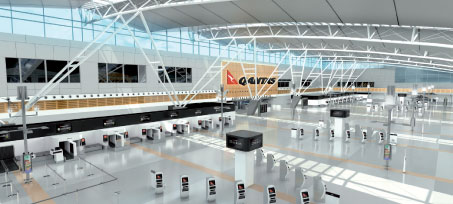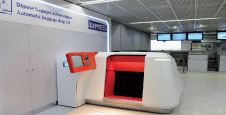
Following the successful trial in Paris-Orly Terminal Ouest, AdP will permanently implement the automatic baggage drop off system in other terminals, before introducing it to Paris-CDG. (Copyright: Aéroports de Paris)
Having started the trial of its innovative automatic baggage drop off system at Paris-Orly Airport in November, Aéroports de Paris (AdP) is now preparing to introduce the self-service solution on a permanent basis. Ryan Ghee spoke to Sébastien Pichereau, senior manager – airport capacity development, AdP.
The trend of self-service in the airport environment is continuing to gather pace and while automatic check-in and boarding processes are becoming increasingly popular, airports are also exploring how baggage processing can be further automated to improve efficiency.
In this area, Aéroports de Paris has emerged as one of most innovative airport operators and since November it has been trialling an automatic baggage drop off solution that was developed in-house and implemented at Paris-Orly Airport’s Terminal Ouest.
The system is designed to empower the passenger and make the bag drop process as simple as possible. Once the passenger has checked-in and printed their boarding pass and bag tags, they can proceed to the automated baggage area. Then they simply have to scan their boarding pass and insert their baggage into the machine. The passenger’s name and the weight of the bag are then verified and a baggage receipt is automatically printed. Within 30 seconds, the bag is checked-in before being inspected and secured on its way to the aircraft hold.
“In the first three months, the machine processed around 15,000 bags,” Pichereau said. “We recently undertook a passenger survey and 99% of passengers were satisfied. Also, it’s working well for the airlines and the operating agents are very happy with the performance.”
ICM’s Auto Bag Drop
ICM Airport Technics, along with Qantas, has developed a new Auto Bag Drop system, 80 of which are already in operation across six Australian airports. The system has already processed 6 million bags since its implementation.
The self-service Bag Drop allows passengers to check-in their baggage without having to queue at a check-in desk. A touch-screen monitor welcomes the passenger, before the system scans the boarding pass. Boarding details are checked and validated and the passenger places their bag on the weighscale conveyor, using a tub if necessary. The bag is weighed, dimensions are checked and excess payments are calculated. If excess weight is detected, the passenger can opt to pay the excess or to re-pack the bag. A Heavy Tag is printed, if required. The bag is then processed, the bag tag is activated and the bag is sent to the baggage handling system.
The system, which is Radio Frequency Identification (RFID)-enabled for boarding passes and bag tags, is based on a two-step process. The first step consists of kiosk or online check-in, while the baggage drop off takes place in the second step. By using this process, the baggage check-in time is reduced to between 15-45 seconds and queues at the check-in counter are also reduced.
Following the success of the system in Australia, a number of major airlines have expressed an interest in adopting the Auto Bag Drop system.

The Auto Bag Drop system has already processed 6 million bags in six Australian airports.
Two-step process
For an airport considering the implementation of a self-service bag drop system, one of the key considerations is to decide whether to opt for a one- or two-step process. The former entails the tagging and deposit of the baggage in a single transaction, while the latter requires the baggage to be tagged in one location and then dropped off at a separate area.

In the first three months of the trial, AdP’s automatic baggage drop off system successfully processed 15,000 bags.
“We went for the two-step process,” Pichereau explained. “When we were thinking about the product, firstly there was the IATA (International Air Transport Association) recommendation for the two-step process. Also, at AdP, we think the passenger should spend as little time as possible at the drop off point as this is a capacity bottleneck.”
He continued: “When we started to look at this process in 2009, there was no product based on the two-step process on the market at that time. Also, in 2009, we launched an innovation process within AdP and with a dedicated team, we decided that we would develop this product ourselves for our own needs.”
Among the key aims, Pichereau explained, was to ensure that the product was easy to use for the passenger, while also optimising passenger throughput for the airport. It also had to satisfy European Union and French security regulations. Having successfully satisfied these criteria, the focus is now on expanding the presence of the automatic baggage drop off system.
“The trial ends in May and we then plan to deploy this machine in other terminals,” Pichereau said. “Firstly, we’ll deploy it across Paris-Orly as we need to deploy several machines to get an idea of the throughput we can deal with.” Once this has been completed, the next stage will be to introduce the system to Paris-Charles de Gaulle Airport.







